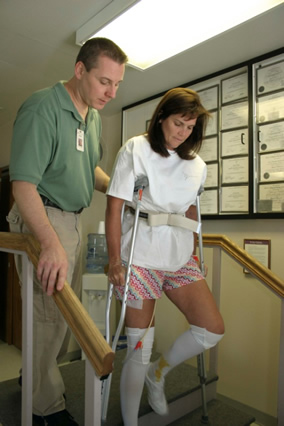Managing Pain after Total Hip Replacement Surgery
by Kimmie Rollison Health Consultant & WriterPatients about to undergo total hip replacement surgery have many questions, and among the most general ones are those relating to pain management. After surgery, hip replacement patients want to know whether they will be able to sleep properly with pain medicines. How much uncomfortable they will be while performing the daily life activities? They will also like to know about the new drugs they will have to take. It is therefore recommended, that patients should prepare themselves for hip surgery by learning what their body would demand after surgery. Moreover, understanding pain management is crucial for a healthy recovery.

Pain Management Following Hip Replacement Surgery
Pain management is in fact a matter of managing one's expectations. Keep in mind that operation on any part of the body, mainly the hip and knee needs a particular period of rest for the body to recover its original strength. Do not expect to continue with the regular daily activities within a few days following surgery. Though the period of post-surgical pain for hip replacement surgery is notably shorter than knee replacement surgery, the patient will still need to give their hip the time it takes for recovery.
Here in this article below are given some of the simple ways by which one can manage post-operative pain.
Rest During First Week
During the first week of recovery, take frequent rest and be active only in small issues. The more rest you give to the body during this particular time, the better. By the 10thday, patients must consult the doctor and a major improvement in pain levels should be observed. Mostly after ten days, joint pain vanishes away, and the soft tissue pain is easing. Some patients may use a cane for four weeks following surgery. After 5 to 6 weeks, patients can resume their regular activities.
Ice Can Lower pain
Ice can lower the pain alongside medication and with less critical pain it can be used on its own. For patients undergoing hip replacement, it is recommended that they use gel packs and keep them in the freezer. At the time of healing, the patient needs to change the ice packs frequently. Do not forget to protect the skin as these new gel packs can quickly burn. Also remember to raise the legs and rest it on the icing.
Medicating with Pain Killers
Initially, patients are sent home with strong painkillers. Moreover, patients can get refills for their prescriptions from the surgeon or primary care physician. Painkillers may be in the form of patches or tablets but make sure that the patient takes them according to the instructions given. Some find it mandatory to continue with pain management for up to twelve weeks. It isn’t surprising and should not be seen as a weakness. If medications given by the doctor is not enough to treat pain, one can always talk to the doctor about increasing the dosage, or they may also consult with the primary physician. Enduring additional amounts of pain after hip replacement surgery is not recommended just because swelling can occur & may eventually lead to inflammation and greater suffering. Again, keep an open communication with the doctor or primary physician about levels of pain.
Elevate Legs while Sitting or Sleeping
Raising legs will also help in reducing pain and swelling. By putting feet higher than hips, the patient will be able to offset some of physical discomfort in legs. Inside bed, one can prop their feet up on rolled-up blankets at the end of the bed; in a chair, one can use pillows; on a recliner, one can also use pillows. Regular practice of elevating the legs several times a day combined with icing and the proper medication will significantly help in managing pain.
Managing Pain After Hip Replacement Surgery
After initial sharp pain has subsided, some patients observed that, a more deeper and achy pain radiates within the hip joint. Sometimes pain may exacerbate as well and to treat this, patients may take a dose of medication about an hour before the physical therapy sessions. In case where one feels a sharp pain out of nowhere, especially a pain the patient had never felt before, contact the physician immediately. It occurs during exercises or physical therapy, and it usually indicates pain in one of the muscles or ligaments surrounding the hip joint.
Sponsor Ads
Created on Dec 31st 1969 18:00. Viewed 0 times.



